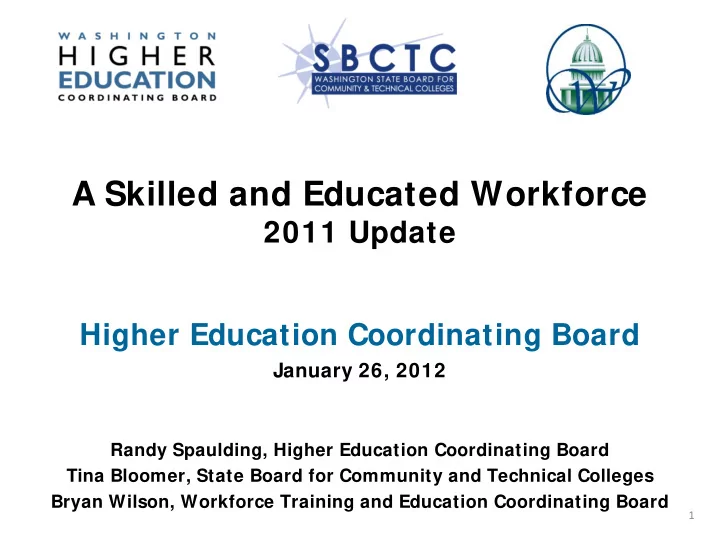

A Skilled and Educated Workforce 2011 Update Higher Education Coordinating Board January 26, 2012 Randy Spaulding, Higher Education Coordinating Board Tina Bloomer, State Board for Community and Technical Colleges Bryan Wilson, Workforce Training and Education Coordinating Board 1
Purpose of this report The report is required under 28B.76.230 to assess “the number of forecasted net job openings at each level of higher education and training and the number of credentials needed to match the forecast of net job openings.” The report addresses this mandate using the long range occupational forecast and estimates of program graduates who would likely be entering the workforce. It should be noted that: The report does not fully address the impact of new and emerging occupations and industries (due to limitations of the forecast). The report looks at the post-recessionary period expected during 2014-2019. The report assumes no net in-migration into Washington of certificate and degree holders. 2
The report addresses two major issues 1) Identification of High Employer Demand Occupations 2) Aggregate Demand for higher education degrees and certificates 3
Education Level Workers with higher levels of education tend to earn more and experience lower rates of unemployment. At each level there is a range of earnings that varies by field of study and occupation. 2010 Wages and Unemployment by Education Level 120,000 18% (20th Percentile, Median, 80th Percentile) 16% 100,000 14% Unemployment Rate 80,000 12% Wages 65,496 10% 60,000 52,396 8% 40,305 36,274 40,000 6% 34,259 30,229 4% 20,152 20,000 Unemployment 2% - 0% Less than High High School Less than 1 1+ years Associate Bachelor's Graduate School Graduate Year College college, no Degree Degree Degree degree Source: 2010 American Community Survey. Wages Include civilian employed WA residents age 25-64. Unemployed rate reflects civilian labor 4 force for WA residents age 25-64.
Gap Analysis • Gaps are calculated based on current supply and anticipated annual demand by education level in 2014-2019. • For occupations the analysis looks at the size of the gap and occupations with unique education and training requirements. • The analysis recognizes that training at a variety of levels is required for some occupations. 5
Supply and Demand Annual Supply and Demand of Workers by Education Level 2010 Supply and Annual Average Openings 2014-2019 34,000 9,000 Mid-Level / Associate Degree 26,000 10,000 Bachelor's Degree 11,000 9,000 Graduate / Professional Degree - 5,000 10,000 15,000 20,000 25,000 30,000 35,000 40,000 45,000 50,000 2010 Completers Entering the Laborforce Additional Degrees Needed Annually by 2019 to Meet Employer Demand 6
Mid Level Gap Analysis High Employer Demand Occupations at the Mid Level 2010 Supply compared to 2014-2019 Demand Health Occupations in Shortage* 3,186 369 Installation, Maintenance, Repair 1,164 1,770 Manufacturing, Production 758 1,117 Accounting & Bookkeeping 759 602 Protective Services 584 759 Science Technology 44 135 - 500 1,000 1,500 2,000 2,500 3,000 3,500 4,000 2010 Completers Entering the Laborforce Additional Supply needed each year to meet demand 2014-2019 *includes only mid-level health occupations with projected shortages 7
Baccalaureate Gap Analysis High Employer Demand Occupations at the Baccalaurate Level. 2010 Supply compared to 2014-2019 Demand Computer Science 1,560 1,276 Health Professions 2,006 528 Engineering, Software Eng, and 856 719 Architecture Life Sciences and Agriculture 191 111 Physical sciences 105 158 - 500 1,000 1,500 2,000 2,500 3,000 2010 Completers Entering the Laborforce Additional Supply needed each year to meet demand 2014-2019 8
Graduate Gap Analysis High Employer Demand Occupations at the Graduate Level. 2010 Supply compared to 2014-2019 Demand Health Professions 1,987 718 Computer Science 1,181 681 Engineering, Software Eng, and Architecture 753 428 Human and Protective Service 913 220 Life Sciences and Agriculture 526 355 Physical sciences 273 201 - 500 1,000 1,500 2,000 2,500 3,000 2010 Completers Entering the Laborforce Additional Supply needed each year to meet demand 2014-2019 9
Where have we made progress? Annual Registered Nursing Program Completions 2003-2010 3,500 3,000 2,500 1,190 1,155 1,058 2,000 1,001 925 851 1,500 796 734 1,000 1,695 1,696 1,695 1,419 1,318 1,105 500 995 958 - 2003 2004 2005 2006 2007 2008 2009 2010 Associate Baccalaureate Source: Health Professions Education In Washington State: 2003—2010 Completion Statistics. Workforce Training and Education Coordinating Board, 2011 10
Aerospace Workforce Requirements • A higher share of the workforce is employed by the Aerospace industry in Washington than in any other state – and we rank second to California in overall aerospace employment. • Recent increases in the Boeing orders have yet to be reflected in detailed labor market forecasts for the aerospace industry. • However, employer surveys and Census data, allow us to identify the general mix of occupations used in Washington’s aerospace industry. 11
Key Aerospace Occupational Groups Approximate Primary Recent Labor Education Occupational Group Force Level(s) Engineers & Engineering Managers (primarily Aerospace & Industrial ) 14,000 BA, some grad Certificates, some Aircraft Assembly & Maintenance Specialties 8,000 AA & OJT IT – Primarily Programmers, Engineers and Scientists 6,000 BA BA, some Procurement, Budget, Logistics, Operations Research 4,000 certificates AA, Certificate, Drafting & Engineering Technicians 3,500 BA Machinists 3,000 Certificates General Production & Assembly Occupations 3,000 Certificates, OJT Inspectors, testers, samplers, incl. transportation inspectors 3,000 Certificates, OJT Computer & Numerical Controlled Manufacturing 2,000 Certificates Production Supervisors 1,600 BA to OJT 12
Next Steps Work on final printed report is in progress. Series of follow-up briefs: • Aerospace industry • Education and related occupations • Healthcare occupations 13
Questions? Contact: Randy Spaulding, Higher Education Coordinating Board, randys@hecb.wa.gov. Tina Bloomer, State Board for Community and Technical Colleges, tbloomer@sbctc.edu. Bryan Wilson, Workforce Training and Education Coordinating Board, bwilson@wtb.wa.gov. 14
Recommend
More recommend